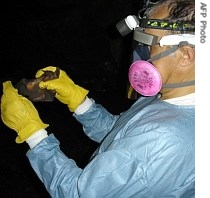2007年VOA标准英语-Researchers Blame Bats for Marburg Outbreak in(在线收听)
Nairobi
23 August 2007
Medical researchers studying the recent outbreak of Marburg hemorrhagic fever in Uganda say common bats are the most likely source of the outbreak. VOA Correspondent Alisha Ryu in our East Africa Bureau in Nairobi spoke to one of the lead scientists, who says the data shows more areas in Africa are at risk for Marburg outbreaks than previously thought.
 |
| A member of a WHO ecological team, holds a bat in a lead and gold mine in Kitaka, Uganda, 12 August 2007 |
Lead investigator, Dr. Pierre Rollin, says other teams have been testing bats in several other regions of Africa. Among the 1,100 bats of 10 species tested, scientists have detected the Marburg virus in only one common type of fruit bat that lives deep inside caves and mines.
Four of the fruit bats tested positive for the virus and more than 20 others showed low levels of antibodies to the virus.
"The infected bat excretes the virus in urine, feces, saliva," he said. "And the people are in contact with these bats in a very confined area. We think in this way, people can be infected by breathing, or having some secretions or excretions on their skin, in the eyes."
In Uganda, the tallest chamber in the mine measured just three meters high and investigators say workers digging through the mine would have had frequent contact with bats and their waste.
Dr. Rollin says the test results are significant, because they confirm scientists' long-held belief that an animal, particularly bats, was a reservoir for the Marburg virus. Separate studies have identified three species of fruit bats as being the likely carriers of the related, but more lethal, Ebola virus.
Early symptoms of both the Ebola and Marburg viruses include high fever, chills, and severe headaches. Late-stage infections could include multi-organ failures and sometimes gruesome hemorrhaging from openings in the body. Close contact with the bodily fluids of infected people can rapidly spread the disease among humans.
Since the Marburg virus was first identified in 1967, it has killed people in South Africa, Uganda, and Kenya. In Congo Kinshasa, a major outbreak killed 123 people in a gold mining community between 1998 and 2000. The worst known outbreak of Marburg fever occurred two years ago in Angola, where as many as 300 people died of the disease.
Dr. Rollin says because there are millions of cave-dwelling fruit bats throughout Africa, scientists have to now assume that more areas of the continent are at risk for Marburg fever outbreaks.
He says until a vaccine is found to prevent the disease, people need to take precautions, such as wearing protective clothing and masks in caves and mines.
"There is no way to control the bats," he added. "Nobody thinks that you can diminish the population, eradicate the bats. If you can avoid them, leave the bats where they are. Leave them alone and they will leave you alone."
The medical investigators are expected to continue their field research for another two weeks in an attempt to find a bat from which they can isolate the Marburg virus.